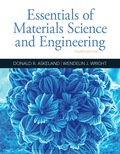
(a)
Interpretation:
The application of alumina should be determined.
Concept Introduction:
Alumina is short and convenient name given to aluminum oxide. It is designated by Al2O3.
It is also known as aloxite or alundum.
Properties of aluminum are:
- It is white in color.
- It is odorless in nature.
- It is insoluble in water.
- It is having a density of 3.987 g/cm3.
(b)
Interpretation:
The application of silica should be determined
Concept Introduction:
Silica is a short name provided for silicon dioxide. Its chemical designation is SiO2. Silica is a major constituent of sand.
Properties of silica are:
- It is transparent.
- Its melting point is 1,713 degree Celsius.
- The boiling point is 2950 degree Celsius.
- It appears in white color.
- It affects immune system.
(c)
Interpretation:
The applications barium titanate should be determined.
Concept Introduction:
Barium titanate whose chemical formula is BaTiO3. It is an organic compound.
The properties are:
- It appears in powder from.
- It appears white in color.
- It is odorless in nature.
- It is insoluble in water.
- It dissolves in concentrated HF acid.
(d)
Interpretation:
The applications of zirconia should be determined.
Concept Introduction:
Zirconia is short form termed to zirconium dioxide.It is naturally occurring form with a monoclinic crystalline structure.
Properties of zirconium are:
- It appears white in color.
- It appears in powdered form.
- Its density is 5.68 g/cm3.
- It's melting point is 2,715 degree Celsius.
- Its boiling point is 4,300 degree Celsius.
(e)
Interpretation:
The applications of diamonds should be determined.
Concept Introduction:
Diamond is a crystal which is typically used as gemstone among which diamonds age 1 billion to 3.5 billion years old.
Properties of the diamond are as follows:
- They have high hardness.
- They are chemically stable.
- They appear in various colors like yellow, colorless, brown and grey as well.
- They are isotropic in nature.
Want to see the full answer?
Check out a sample textbook solution
Chapter 15 Solutions
Essentials Of Materials Science And Engineering
- What is the moment of Inertia of this body? What is Ixx, Iyy, and Izzarrow_forwardQ11arrow_forwardMethyl alcohol at 25°C (ρ = 789 kg/m³, μ = 5.6 × 10-4 kg/m∙s) flows through the system below at a rate of 0.015 m³/s. Fluid enters the suction line from reservoir 1 (left) through a sharp-edged inlet. The suction line is 10 cm commercial steel pipe, 15 m long. Flow passes through a pump with efficiency of 76%. Flow is discharged from the pump into a 5 cm line, through a fully open globe valve and a standard smooth threaded 90° elbow before reaching a long, straight discharge line. The discharge line is 5 cm commercial steel pipe, 200 m long. Flow then passes a second standard smooth threaded 90° elbow before discharging through a sharp-edged exit to reservoir 2 (right). Pipe lengths between the pump and valve, and connecting the second elbow to the exit are negligibly short compared to the suction and discharge lines. Volumes of reservoirs 1 and 2 are large compared to volumes extracted or supplied by the suction and discharge lines. Calculate the power that must be supplied to the…arrow_forward
- Do question 9 please! Question 7 Is just there for reference!!arrow_forward2) The transistor parameters of the NMOS device in the common-gate amplifier in Figure 2 are VTN = 0.4V, K'n = 100 μA / V², and λ=0. (50 points) a) Find RD such that VDSQ = VDs (sat) + 0.25V. b) Determine the transistor W/L ratio such that the small-signal voltage gain is Av=6. c) What is the value of VGSQ? Сс 2 mA Rp T V=-1.8 V V+= 1.8 V Figure 2arrow_forwardAnswer the question fully and accurately by providing the required files(Java Code, Two output files and written answers to questions 1-3 in a word document)meaning question 1 to 3 also provide correct answers for those questions.(note: this quetion is not graded).arrow_forward
- can you help me figure out the calculations so that i can input into autocad? Not apart of a graded assinment. Just a problem in class that i missed.arrow_forwardCalculate the percent voltage regulation for a three-phase wye-connected 2500 kVA 6600-V turboalternator operating at full-load Unity power factor The per phase synchronous reactance and the armature resistance are 10.4 2 and 0.071 ≤2, respectively?arrow_forwardConsider a glass window (Hight = 1.2 m, Width = 2 m). The room thatfaces the window are maintained at 25 o C. The average temperature ofthe inner surface of the window is 5 o C. Calculate the total heat transferrate from through the window a) IdenCfy what type(s) of convecCon is important (circle one). • external forced (Chapter 7)• internal forced (Chapter 8)• natural convecCon (Chapter 9)• boiling and condensaCon (Chapter 10)b) IdenCfy the necessary equaCon(s) needed to solve the problem. c) IdenCfy important fluid properCes you need to solve the problem. d) Calculate the total heat transferred.arrow_forward
 MATLAB: An Introduction with ApplicationsEngineeringISBN:9781119256830Author:Amos GilatPublisher:John Wiley & Sons Inc
MATLAB: An Introduction with ApplicationsEngineeringISBN:9781119256830Author:Amos GilatPublisher:John Wiley & Sons Inc Essentials Of Materials Science And EngineeringEngineeringISBN:9781337385497Author:WRIGHT, Wendelin J.Publisher:Cengage,
Essentials Of Materials Science And EngineeringEngineeringISBN:9781337385497Author:WRIGHT, Wendelin J.Publisher:Cengage, Industrial Motor ControlEngineeringISBN:9781133691808Author:Stephen HermanPublisher:Cengage Learning
Industrial Motor ControlEngineeringISBN:9781133691808Author:Stephen HermanPublisher:Cengage Learning Basics Of Engineering EconomyEngineeringISBN:9780073376356Author:Leland Blank, Anthony TarquinPublisher:MCGRAW-HILL HIGHER EDUCATION
Basics Of Engineering EconomyEngineeringISBN:9780073376356Author:Leland Blank, Anthony TarquinPublisher:MCGRAW-HILL HIGHER EDUCATION Structural Steel Design (6th Edition)EngineeringISBN:9780134589657Author:Jack C. McCormac, Stephen F. CsernakPublisher:PEARSON
Structural Steel Design (6th Edition)EngineeringISBN:9780134589657Author:Jack C. McCormac, Stephen F. CsernakPublisher:PEARSON Fundamentals of Materials Science and Engineering...EngineeringISBN:9781119175483Author:William D. Callister Jr., David G. RethwischPublisher:WILEY
Fundamentals of Materials Science and Engineering...EngineeringISBN:9781119175483Author:William D. Callister Jr., David G. RethwischPublisher:WILEY





